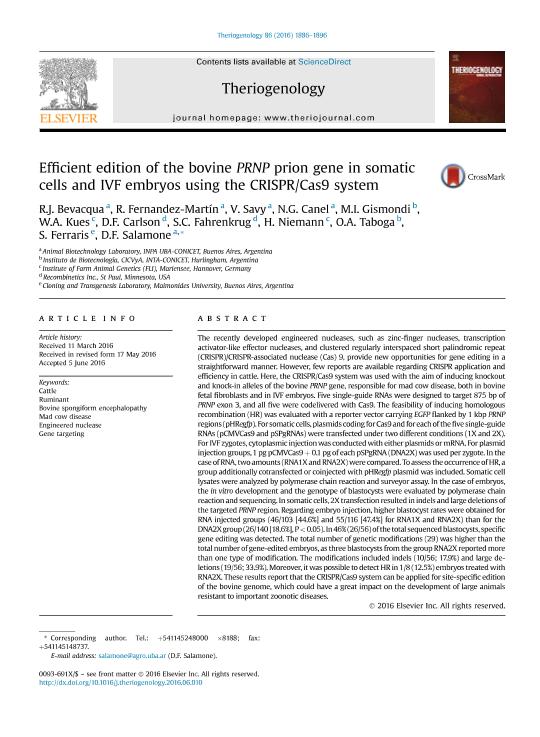Artículo
Efficient edition of the bovine PRNP prion gene in somatic cells and IVF embryos using the CRISPR/Cas9 system
Bevacqua, Romina Jimena ; Fernández y Martín, Rafael
; Fernández y Martín, Rafael ; Savy, Virginia
; Savy, Virginia ; Canel, Natalia Gabriela
; Canel, Natalia Gabriela ; Gismondi, Maria Ines
; Gismondi, Maria Ines ; Kues, W. A.; Carlson, D. F.; Fahrenkrug, S. C.; Niemann, H.; Taboga, Oscar Alberto
; Kues, W. A.; Carlson, D. F.; Fahrenkrug, S. C.; Niemann, H.; Taboga, Oscar Alberto ; Ferraris, S.; Salamone, Daniel Felipe
; Ferraris, S.; Salamone, Daniel Felipe
 ; Fernández y Martín, Rafael
; Fernández y Martín, Rafael ; Savy, Virginia
; Savy, Virginia ; Canel, Natalia Gabriela
; Canel, Natalia Gabriela ; Gismondi, Maria Ines
; Gismondi, Maria Ines ; Kues, W. A.; Carlson, D. F.; Fahrenkrug, S. C.; Niemann, H.; Taboga, Oscar Alberto
; Kues, W. A.; Carlson, D. F.; Fahrenkrug, S. C.; Niemann, H.; Taboga, Oscar Alberto ; Ferraris, S.; Salamone, Daniel Felipe
; Ferraris, S.; Salamone, Daniel Felipe
Fecha de publicación:
11/2016
Editorial:
Elsevier Science Inc
Revista:
Theriogenology
ISSN:
0093-691X
Idioma:
Inglés
Tipo de recurso:
Artículo publicado
Clasificación temática:
Resumen
The recently developed engineered nucleases, such as zinc-finger nucleases, transcription activator-like effector nucleases, and clustered regularly interspaced short palindromic repeat (CRISPR)/CRISPR-associated nuclease (Cas) 9, provide new opportunities for gene editing in a straightforward manner. However, few reports are available regarding CRISPR application and efficiency in cattle. Here, the CRISPR/Cas9 system was used with the aim of inducing knockout and knock-in alleles of the bovine PRNP gene, responsible for mad cow disease, both in bovine fetal fibroblasts and in IVF embryos. Five single-guide RNAs were designed to target 875 bp of PRNP exon 3, and all five were codelivered with Cas9. The feasibility of inducing homologous recombination (HR) was evaluated with a reporter vector carrying EGFP flanked by 1 kbp PRNP regions (pHRegfp). For somatic cells, plasmids coding for Cas9 and for each of the five single-guide RNAs (pCMVCas9 and pSPgRNAs) were transfected under two different conditions (1X and 2X). For IVF zygotes, cytoplasmic injection was conducted with either plasmids or mRNA. For plasmid injection groups, 1 pg pCMVCas9 + 0.1 pg of each pSPgRNA (DNA2X) was used per zygote. In the case of RNA, two amounts (RNA1X and RNA2X) were compared. To assess the occurrence of HR, a group additionally cotransfected or coinjected with pHRegfp plasmid was included. Somatic cell lysates were analyzed by polymerase chain reaction and surveyor assay. In the case of embryos, the in vitro development and the genotype of blastocysts were evaluated by polymerase chain reaction and sequencing. In somatic cells, 2X transfection resulted in indels and large deletions of the targeted PRNP region. Regarding embryo injection, higher blastocyst rates were obtained for RNA injected groups (46/103 [44.6%] and 55/116 [47.4%] for RNA1X and RNA2X) than for the DNA2X group (26/140 [18.6%], P < 0.05). In 46% (26/56) of the total sequenced blastocysts, specific gene editing was detected. The total number of genetic modifications (29) was higher than the total number of gene-edited embryos, as three blastocysts from the group RNA2X reported more than one type of modification. The modifications included indels (10/56; 17.9%) and large deletions (19/56; 33.9%). Moreover, it was possible to detect HR in 1/8 (12.5%) embryos treated with RNA2X. These results report that the CRISPR/Cas9 system can be applied for site-specific edition of the bovine genome, which could have a great impact on the development of large animals resistant to important zoonotic diseases.
Archivos asociados
Licencia
Identificadores
Colecciones
Articulos(INPA)
Articulos de UNIDAD EJECUTORA DE INVESTIGACIONES EN PRODUCCION ANIMAL
Articulos de UNIDAD EJECUTORA DE INVESTIGACIONES EN PRODUCCION ANIMAL
Articulos(SEDE CENTRAL)
Articulos de SEDE CENTRAL
Articulos de SEDE CENTRAL
Citación
Bevacqua, Romina Jimena; Fernández y Martín, Rafael; Savy, Virginia; Canel, Natalia Gabriela; Gismondi, Maria Ines; et al.; Efficient edition of the bovine PRNP prion gene in somatic cells and IVF embryos using the CRISPR/Cas9 system; Elsevier Science Inc; Theriogenology; 86; 8; 11-2016; 1886-1896
Compartir
Altmétricas



